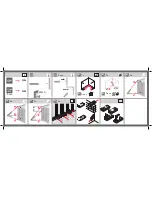
Subject to modifications
User Manual
Technical Description
2.2A-10003-B06
LINCOLN GmbH & Co. KG • Postfach 1263 • D-69183 Walldorf • Tel +49 (6227) 33-0 • Fax +49 (6227) 33-259
Page 9 of 40
Description
Progressive Metering Device Model SSV D
6496b05
Fig. 9
Schematic of the SSV D metering device
1 - 6 Outlets
A - C Control and metering piston
Progressive Plunger Metering Devices, General
The progressive metering devices
- are piston-operated metering devices.
- automatically (progressively) dispense the lubricant fed
by the pump to the connected lubrication points.
- have a
lubricant output of
0.07 / 0.14 / 0.2 / 0.3 / 0.4 /
0.6 / 0.8 / 1.0 / 1.4 und 1.8 cm³ per outlet and piston
stroke (see page 12, paragraph „Metering Screw “).
- when one or more outlets are closed (see page 17,
paragraph „Cross-porting of Outlets“) they can dispense
double or multiple lubricant quantities.
- are available with 1 to 22 outlets.
- offer the option of combining several lubrication points
into one centralized lubrication point.
- meter the supplied lubricant into predetermined single
quantities.
- can be monitored visually (see indicator pin, Fig. 22,
page 18) or electronically (see piston detector or prox-
imity switch, Fig. 23, page 19).
- offer optimum metering possibilities by means of one or
more subsequently positioned SSV D metering devices.
Any blockage in a lubrication circuit is indicated by grease
leaking from the respective pressure relief valve.
6512b05
Fig. 10
Metering and control piston assy
1 -
Metering piston
2 -
Control piston
P -
Input pressure
D -
Larger metering piston diameter
d -
Smaller control piston diameter
S -
Larger fit-tolerance of the metering piston
s -
Smaller fit-tolerance of the control piston
L -
Continual running surfaces of metering piston and cylinder
l -
Interrupted running surfaces of control piston and cylinder
Features of a Progressive Metering Device
The term ”progressive
” refers to the special features of
the lubricant distribution within the metering devices,
e.g.
- the successive movements of the individual pistons
within the metering device due to the supplied lubricant
being under pressure;
- the pistons move in a predetermined order and the cy-
cles are repeated constantly;
- each piston must have completed its movement fully
before the next piston can be moved, no matter whether
the lubricant is dispensed continuously or intermittently;
- the pistons operate interdependently of one another;
- no lubrication point that is connected to the system is
omitted.
Function Principle and Reliability
The progressive function sequence results from the inter-
action (see Fig. 12-18, as of page 11) of each metering
and control piston assy (see Fig. 10) whereby the meter-
ing piston has priority over the control piston.
The softer running of the metering piston is warranted by
several factors:
- Larger piston surface D at constant input pressure P in
the total SSV D
- Assembly with larger fit-tolerance S
- Continual running surfaces of piston and cylinder










































